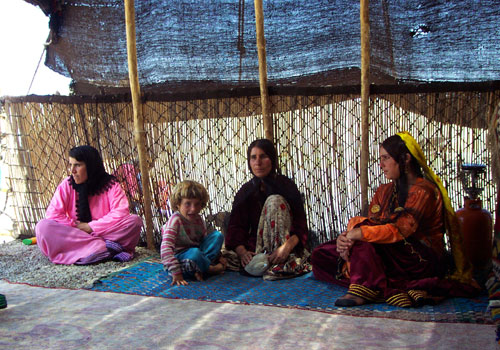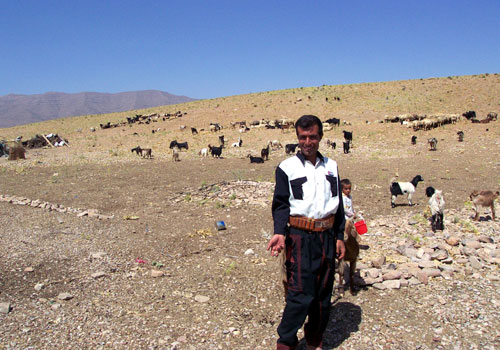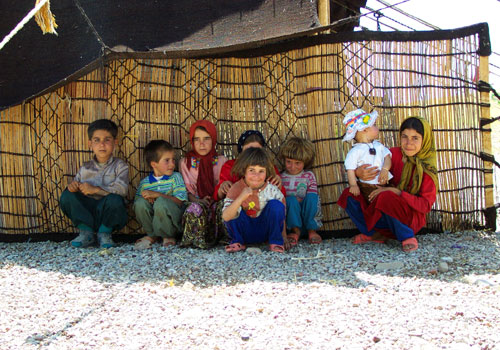(A Meta-narrative?)
For centuries the Fars region had been a multi-ethnic region, in which tribal and pastoral nomadic groups composed a large part of the population.
Turkic-speaking pastoral nomadic tribal groups began entering central and southern Iran, at least, during the eleventh and twelfth centuries. The historical movement of larger and smaller groups of pastoral nomadic households of different ethnic backgrounds, including Turks, into and out of the Fars region continued up to the nineteenth century. The Qashqai, as a large tribal unit, dates back at least to the early eighteenth century, when some Turkish(Turki)-speaking tribal groups in the region existed under the name Qashqai and leadership of the head(s) of a certain lineage called Shahilu.
In addition to pastoralism for use and exchange, various nomadic households of the Fars region during the nineteenth century relied on different combinations of a variety of economic activities–such as agriculture, handicrafts production, and gathering; for use and exchange. Exchange of labor (in a variety of contracts with property owners), trade, providing protection and transportation facilities for traders, and, for some, banditry and raiding, were other potential household economic resources.
During the nineteenth century, the Qashqai was gradually transformed into a large tribal confederacy composed of, mainly, Turkish-speaking pastoral nomads. Their summer pastures stretched to areas in central Iran, and their winter pastures to areas close to the Persian Gulf. Many Turkic-speaking tribal groups, as well as groups belonging to other ethnic groups in the region, were integrated into the Qashqai. The non-Turk groups, in time, adopted the language and other ethnic identity markers of the Qashqai. Perhaps more than a quarter of the region’s population was pastoral nomadic about the mid-nineteenth century.
Generally speaking, during the nineteenth century the Qashqai became increasingly, though with ebbs and flows, hierarchical and centralized. Its official political hierarchy was part of the regional state structure for purposes of ‘tax and order.” The growth of political centralization and expansion of the Qashqai population and territory in this period paralleled changes in the larger regional political economy. There was an increasing articulation of the region’s political economy with the world market. This process included a rise in production of agricultural and pastoral products for the market and consumption of imported goods, growth in the monetization of the administrative system and the economy, relative centralization of the state apparatus, the spread of private forms of land ownership, and expansion of mercantile, financial, and landed capital. Though Iran never became an official colony of either Russia or Britain, Fars and other regions in southern Iran were under the economic and political influence of Britain during this period.
The economic changes mentioned above were unevenly effective among the region’s various local communities, including various Qashqai groups. The whole nineteen-century transformation process was complex, uneven, and paradoxical. Alongside Western political and economic sway, the modern Iranian nation and nationalism gradually emerged. Likewise, parallel to the emergence of the Iranian nation, some modern Iranian ethnic groups took their beginnings. In Fars, abreast of the general trend of expansion and centralization of the state and some tribal groupings, dispersion of some other larger tribes, internal tribal strife and acts of rebellion, brigandage, and “lawlessness,” especially in certain periods, intensified.
The Qashqai as an Ethnic Group
The Qashqai are distinguished from other ethnic groups in the region by identification as Turk, or Qashqai, by themselves and others. Their identity includes a common political history, present social ties, and a shared cultural and linguistic heritage. Most Qashqai are, at least, bilingual in Persian (Farsi).
Other major ethnic groups in Fars in the nineteenth century were the Tajik (non-tribal and Persian speaking villagers and city dwellers, also called Tat, or sometimes referred to as Fars), and the Lurs, and the Arabs (or later the Arab-Basseri). The Lurs and the Arabs were also considered “tribal.”
There are other non-Qashqai but Turkic-speaking communities in Fars. Three out of five large tribal groups that were formed into the Khamseh confederacy of eastern Fars in the second half of the last century are Turkic-speaking, so are many smaller settled and semi-settled communities throughout Fars. These three Turki-speaking tribes of eastern Fars (sometimes referred to as “Turk-e Arab”), regarded themselves as culturally close to the Qashqai, and generally sided with the majority of them in some of the major social dramas of the region’s history during the nineteenth and twentieth centuries. There were many small Turkic-speaking settled rural communities scattered throughout Fars, but for many Qashqai, these were not considered to be “Turk proper,” and in some context referred to them as Tajik or Tat (non-tribal peasants). Ethnic and tribal affiliation shifts were common historical phenomena, so were nomads becoming peasants or peasants becoming nomads and joining tribal groups.
Photo: Arash Shiva, 2002
Premodern Social Structure
I view the Qashqai “premodern,” or “traditional” tribal social structure as characterized by a variety of interrelated “aspects.”
We may call these aspects “structures” and “models” of, or “discourses” on, the Qashqai “traditional tribal society.”
i) There was a hierarchical formal administrative structure that integrated the Qashqai with the state structure (for taxing and “order” purposes).
There were also the hierarchies of (ii) the status groups and of (iii) the socio-economic classes.
There was also (iv) a segmental or branching structure to the whole confederacy and its divisions.
Heads of bandits and raiding groups were also men of power, or, to use Tapper’s (1983) phrase for tribal societies of Iran and Afghanistan, there existed (v) a tribal chief/bandit-rebel dialectic.
Qashqai heads of groups of bandits, rebels, and raiders, similar to the tribal chiefs, were engaged in appropriation and distribution of surplus, and punishment. Typically, tribal rebels could become chiefs; the reverse was also the case.
(vi) Individual and group networks constituted another major aspect of social life. These networks brought individuals and groups across tribal groupings together. They also brought individuals and groups from pastoral, rural, and urban backgrounds in social contact. Regional alliances included urban, rural, and nomadic/tribal forces.
(vii) The political field at local, regional, and national levels was characterized by a flexible system of alliances and counter-alliances. Over time, many individuals and groups changed their political and even tribal and ethnic affiliations.
The flexibility of alliances was even practiced during social dramas, sometimes suddenly in the climax of dramas. Narratives of so many social dramas point to moments of impromptu change of political side, not only by main actors, but also by the larger population, who are the audience, but also actors. Regional alliances normally contained urban, nomadic, and rural forces.
The Qashqai were active participants in the country-side political space. Their migratory routes pass by the region’s capital, Shiraz. In many regional and national upheavals, both during the nineteenth and modern (twentieth-century) eras, the Qashqai also took part in the dramas staged in urban political space.
Modern Period
A transitional or liminal period, covering the first quarter of the twentieth century, dramatically divided the Iranian “premodern” and “modern” historical periods. The economic, political, cultural, and social backgrounds for such a transformation were set in the nineteenth century, particularly its later decades. But, it was during these dramatic quarter-of-a-century-long years of the Constitutional Revolution and the First World War, that Iranian nationalism was communicated to larger segments of the society. In Fars and among the Qashqai, during the nationalist and anti-British movement of the war years, modern ideas on national identity were disseminated, contested, and reconstructed among the larger population.
During much of the twentieth century, the expanding and centralizing modern nation-state dominated the Iranian political field. Populations with a tribal and/or minority ethnic background were diversely reconstructed and transformed in a context characterized by various discourses on nationalism–combined with new ideas on the state, ethnicity, Islam, popular participation, social justice, gender relations, and progress. This trend, part of a larger process of change usually termed “modernity” (or rather multiple and contested modernities) intensified and expanded since the sixties. Similar to many other dominantly non-urban populations in the country, the incorporation of Qashqai masses in the national politics as Iranian citizens has further augmented during and after the Islamic revolution of 1978-79.
Sedentarization of Qashqai nomads, and their increasing involvement in non-pastoral and new economic activities, has intensified since the nineteen sixties. Presently, the Qashqai form mainly settled and semi-settled households. Settled Qashqai are dispersed throughout the region, but mostly in rural and urban locations in north-, mid-, and south-central Fars. There are some Qashqai who live outside southern Iran, and indeed throughout the global village.
With the dissolution and transformation of tribal hierarchies and groupings in the last few decades, the importance of social networks in the way Qashqai construct their daily lives has increased. Transformations of the last few decades have brought new channels of establishing networks in urban areas and in the state apparatus.
The Qashqai population of today is estimated to be over four million individuals. The definition of who could be, or is considered Qashqai, is contextual, multiple, and variable in time and space. This estimate is based on a more inclusive definition. There are no “reliable” statistics on the changing divisions into settled, nomadic and semi-nomadic components.
Photo: Arash Shiva, 2002


